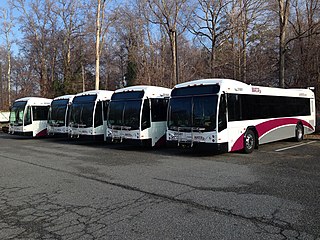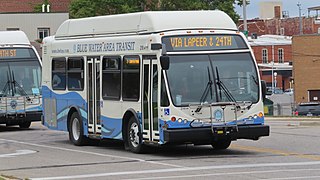
The Southeastern Pennsylvania Transportation Authority (SEPTA) is a regional public transportation authority that operates bus, rapid transit, commuter rail, light rail, and electric trolleybus services for nearly four million people in five counties in and around Philadelphia, Pennsylvania. It also manages projects that maintain, replace and expand its infrastructure, facilities and vehicles.

Trinity Metro is a transit agency located in and serving the city of Fort Worth, Texas and its suburbs in surrounding Tarrant County, part of the Dallas–Fort Worth metropolitan area. Since 1983, it was previously known officially as the Fort Worth Transportation Authority (FWTA), and branded itself as The T. As of January 29, 2018 the Board of Directors has voted to rebrand bus services as Trinity Metro, replacing the previous and long standing name. In 2022, the system had a ridership of 4,761,100, or about 17,900 per weekday as of the third quarter of 2023.

The Hamilton Street Railway (HSR) is the public transport agency for Hamilton, Ontario. The name is a legacy of the company's early period, when public transit in Hamilton was primarily served by streetcars. Although streetcars are no longer used in the city today, the HSR operates bus and paratransit services, with a ridership of 21 million passengers a year.

The Utah Transit Authority (UTA) is a special service district responsible for providing public transportation throughout the Wasatch Front of Utah, in the United States, which includes the metropolitan areas of Ogden, Park City, Provo, Salt Lake City and Tooele. It operates fixed route buses, flex route buses, express buses, ski buses, three light rail lines in Salt Lake County (TRAX), a streetcar line in Salt Lake City, and a commuter rail train (FrontRunner) from Ogden through Salt Lake City to Provo. UTA is headquartered in Salt Lake City with operations and garages in locations throughout the Wasatch Front, including Ogden, Midvale and Orem. Light rail vehicles are stored and maintained at yards at locations in South Salt Lake and Midvale. UTA's commuter rail equipment is stored and serviced at a facility in Salt Lake City. In 2022, the system had a ridership of 31,233,700, or about 119,300 per weekday as of the third quarter of 2023.

The Champaign–Urbana Mass Transit District is a mass transit system that operates in the Champaign–Urbana metropolitan area in eastern Illinois. MTD is headquartered in Urbana and operates its primary hub at the intermodal Illinois Terminal in downtown Champaign. In 2022, the system had a ridership of 7,797,100, or about 24,200 per weekday as of the third quarter of 2023.

Regina Transit is the public transportation agency operated by the City of Regina, Saskatchewan, Canada. It is the oldest public transit system in Saskatchewan and has been city-owned since its inception.

The Detroit Department of Transportation (DDOT) is the primary public transportation operator serving Detroit, Michigan. In existence since 1922, DDOT is a division of the city government, headed by a director appointed by the mayor. Primarily serving Detroit and its enclaves, DDOT is supplemented by suburban service from the Suburban Mobility Authority for Regional Transportation (SMART). In 2022, the system had a ridership of 9,425,700, or about 37,100 per weekday as of the third quarter of 2023.

The Rhode Island Public Transit Authority (RIPTA) provides public transportation, primarily buses, in the state of Rhode Island. The main hub of the RIPTA system is Kennedy Plaza, a large bus terminal in downtown Providence, Rhode Island. Average daily ridership as of the third quarter of 2023 is 40,700. The agency operates 59 fixed-route bus routes and 7 demand-responsive routes, together serving 37 out of 39 Rhode Island municipalities.

Williamsburg Area Transit Authority (WATA) is a multi-jurisdiction transportation agency providing transit bus and ADA Paratransit services in the City of Williamsburg, James City County, York County in the Historic Triangle area and Surry County, VA of the Virginia Peninsula subregion of Hampton Roads in southeastern Virginia.

GoRaleigh is the transit system responsible for operating most of the public transportation services in Raleigh, North Carolina. The system operates 27 fixed routes throughout the city's municipal area and also operates five regional/express routes in partnership with GoTriangle, the regional provider. GoRaleigh is contracted to operate two additional routes, an express route to the Wake Tech Community College campus south of Raleigh and a local circulator service in the Town of Wake Forest. Capital Area Transit, also known as CAT, was rebranded to GoRaleigh in 2015 under the consolidated GoTransit, a joint branding of municipal and regional transit systems for the Research Triangle. In 2022, the system had a ridership of 5,011,500, or about 15,500 per weekday as of the third quarter of 2023.

The Denton County Transportation Authority (DCTA) is the transit authority that operates in Denton County, Texas. It operates transit service in three cities within Denton County, as well as the A-train, a regional commuter rail line to Carrollton. In 2022, the system had a ridership of 2,124,700, or about 11,600 per weekday as of the third quarter of 2023.

The San Diego Metropolitan Transit System is a public transit service provider for central, southern, northeast, and southeast San Diego County, California, as well as for the city of San Diego. The agency directly operates a large transit system that includes the MTS Bus, San Diego Trolley light rail, and Rapid bus rapid transit services. The MTS also controls the San Diego and Arizona Eastern (SD&AE) freight railway and regulates taxicabs, jitneys, and other private for-hire passenger transportation services.

The Jule, formerly known as KeyLine Transit, is the operator of mass transit within the City of Dubuque, Iowa. The Jule offers transit bus routes throughout the city, trolley-replica transportation in Downtown Dubuque and the Port of Dubuque, and on-demand paratransit "MiniBus" service citywide. As of the 2011 rebranding, the transit system and city are now both named after Julien Dubuque. In FY 2010, the Jule recorded 371,000 rides.

The Sioux Area Metro (SAM) is the local governmental transit agency in Sioux Falls, South Dakota, and the state's largest public transportation operator. They provide multiple scheduled fixed routes and paratransit services. Although the city owns the bus fleet the system is currently managed by First Transit and operated under Sioux Area Metro. In 2022, the system had a ridership of 439,600, or about 3,300 per weekday as of the third quarter of 2023.

The South Bend Public Transportation Corporation is a municipal bus system that serves the cities of South Bend and Mishawaka, as well as the nearby suburbs of Notre Dame and Roseland, in the very north of the U.S. state of Indiana. It is the most recent incarnation of the South Bend Railway Company, a street railway company that was founded on May 25, 1885. Transpo receives funding from local, state and federal taxes. In 2022, the system had a ridership of 1,145,500, or about 4,400 per weekday as of the third quarter of 2023.
Terre Haute Transit Utility or Terre Haute City Bus provides public transportation in the city of Terre Haute, Vigo County, Indiana.

Blue Water Area Transit (BWAT) is the public transit operator serving Port Huron, Michigan and surrounding St. Clair County. Operated by the Blue Water Area Transportation Commission (BWATC), the BWAT system includes fixed-route buses in the Port Huron area, plus commuter routes and paratransit services. In 2022, the system had a ridership of 865,300, or about 4,200 per weekday.
The Muskegon Area Transit System (MATS) is the primary provider of mass transportation in Muskegon County, Michigan. Service is provided from Monday through Friday along seven routes. The agency also provides a Complementary ADA Paratransit Service that operates within 3/4 mile of the fixed routes. A micro-transit service called Go2 provides on-demand service Monday-Saturday. Go2 is sponsored by MATS and provided by Via. In 2022, the system had a ridership of 206,900, or about 900 per weekday as of the third quarter of 2023.
Rapid City Rapid Ride is the provider of mass transportation in the City of Rapid City Pennington County, South Dakota providing fixed route bus service since 1992. Five scheduled bus routes operate Monday through Saturday at 30 minutes intervals. Dial-A-Ride provides ADA paratransit service for qualified customers. City View Trolley is a replica trolley service.
Lawton Area Transit System, or LATS, is the primary provider of mass transportation in Lawton, Oklahoma with five routes serving the region. As of 2019, the system provided 346,742 rides over 43,108 annual vehicle revenue hours with 13 buses and 8 paratransit vehicles.
















